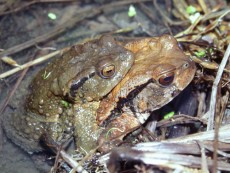|

Scientific Name: Bufo bankorensis Barbour,1908
Common Name: Central formosan toad
Chinese name: 盤古蟾蜍
~~Introduction ~~
The Central Formosan toad is endemic to Taiwan. It is found all over the island from areas of low elevation to mountainous areas at 3000 meters. However, it is found in the largest numbers in mountainous areas from 500 to 1000 meters. Its preferred habitats are reclaimed land, mixed forest, and broad-leaved forest. This species is commonly seen in fruit orchards, along riverbanks and roads and where insects are relatively numerous. The adults and tadpoles are poisonous.
~~ Morphological Characteristics ~~
Adults: This is a large-sized toad. The male measures 6-10cm in length and the female 6-11cm. Some individuals may grow up to 15cm. The skin is rough with many diffuse conical protruding warts, some tipped with white prickles. The snout is obtuse and round and the head is wider than it is long. The tympanum is indistinct. The paratoid gland is long and oval-shaped. It is black along the lower edge. The upper eyelids and parotid glands are covered with prickly warts. The dorsal color varies from yellowish brown to reddish brown, greenish brown, dark brown or grayish black. Some individuals are conspicuously mottled and have a mid dorsal stripe often covered with granules.
~~Taxonomic Studies~~
|
Author
|
Barbour,T.
|
|
Year of publication
|
1908
|
|
Person credited with discovery
|
--
|
|
Date of discovery
|
--
|
|
Reference
|
Barbour, T. 1908. Some new reptiles and amphibians. Bulletin of the Museum of Comparative Zoology, 51(12):315-325.
|
|
Type specimen classification
|
【Holotype】--
|
|
【Paratype】--
|
|
Scientific name changes
|
None
|
~~Ecology and Behavior~~
Due to its extremely large size, the Central Formosan toad moves slowly. The paratoid glands secrete a poisonous substance which serves as a natural defense. When threatened, this toad will tend to puff itself up and prop itself on its limbs to make itself appear intimidating. It prefers to forage under streetlamps where insects gather in relatively large numbers. During the breeding season, the male will approach the female and they will move towards water. Mating is usually carried out in streams or ditches. The female lays approximately 5,000 eggs at one time, which are black in color, in long strings which can measure 10 meters or more in length. The tadpoles are black and are poisonous, often gathering in large groups.
The international digital archives and e-learning communication project of the National Museum of Natural Science
|